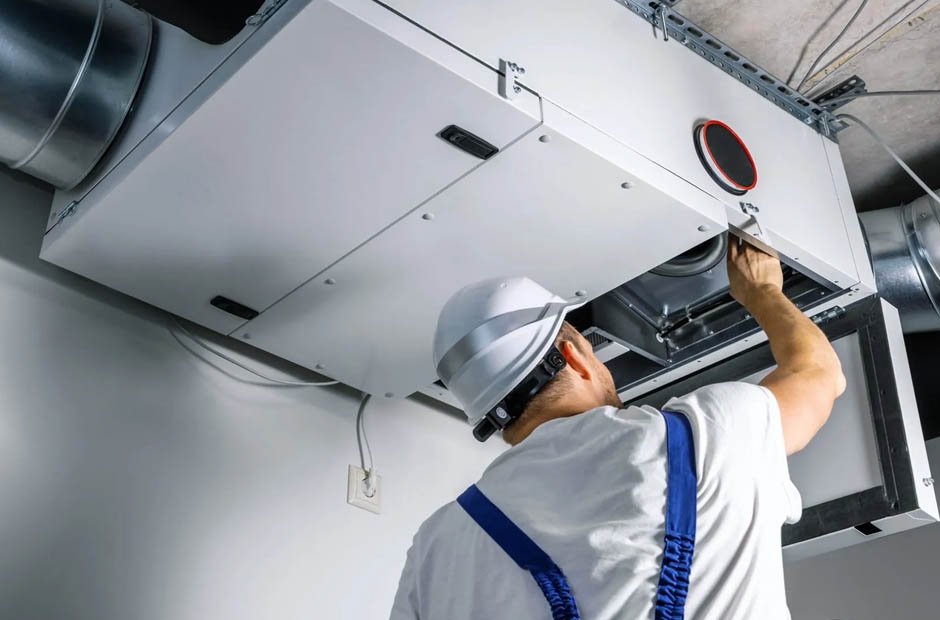Your HVAC system keeps your home comfortable in every season by regulating indoor temperature and airflow. Investing in an HVAC system requires an understanding of the basics, including components, types, and efficiency. Here are some basics of a heating, ventilation, and air conditioning system:
Understanding HVAC Components
The furnace provides heat by using gas, electricity, or oil to warm air before it moves through your home. Air conditioners handle cooling by removing heat from indoor air and releasing it outside. Heat pumps can do both, depending on the season and settings.
Air travels through a network of ducts, helped by an air handler and blower fan that distribute it evenly across rooms. Supply ducts carry conditioned air into your living spaces, while return ducts pull used air back into the system. Filters trap dust, pollen, and other particles to keep the air clean as it circulates through your home.
The thermostat controls how the system cycles, directing it to turn on or off as needed. Manual models allow you to set the temperature yourself, while smart thermostats offer scheduling and remote control capabilities. Each part must work together for your HVAC system to keep your home comfortable and energy-efficient.
Exploring HVAC System Types
Different HVAC systems are available, depending on your home’s size, location, and age. Some system types include:
- Split: These systems use separate indoor and outdoor units to heat and cool your home through ductwork. The indoor unit holds the furnace and evaporator coil, while the outdoor unit contains the condenser and compressor. If you already have ducts in place, this setup may suit your needs well.
- Hybrid split: A hybrid split system combines a heat pump with a furnace, enabling it to switch between gas and electric power. This system helps you manage energy use more efficiently by adjusting to outdoor temperatures. If you live in an area with changing seasons, it gives you more control.
- Ductless: Ductless mini-splits work without ducts and send heated or cooled air directly into each room. You install an indoor unit in the space you want to control.
- Packaged: Packaged systems combine heating and cooling parts in a single outdoor unit.
- Geothermal: These systems utilize underground pipes to transfer heat, allowing you to regulate indoor temperature by relying on the consistent ground temperature.
Managing HVAC Maintenance Requirements
Clean filters help air move freely through the ductwork, helping reduce strain on the system. If airflow is obstructed, the system can overwork and consume more energy. Replacing or cleaning the filter regularly may help achieve higher performance and cleaner indoor air.
Strange sounds, poor air circulation, or consistently varying temperatures can be an indication that something is not functioning properly. An unexpected increase in energy consumption, coupled with an inability to maintain rooms at comfortable temperatures, also indicates a default component. Common malfunctions include worn parts and loose wiring. Routine inspections by a trained technician help identify and address these issues early, preventing costly repairs or system replacement. Technicians can also verify refrigerant levels and clean interior parts to support the system’s function.
Choosing the Right System
Having a system that is compatible with your home affects comfort and energy consumption. Larger houses benefit from a system with a higher output, whereas smaller spaces could require a smaller system. A well-installed system is more likely to perform as expected and respond to your needs efficiently. A trained technician can help you determine a suitable size or setup for your home. Proper installation supports better airflow, consistent temperatures, and fewer long-term issues.
Schedule HVAC Services
Understanding how your system works makes it easier to identify issues and improve efficiency. From selecting the right type to understanding the role of each component, every detail affects performance. Routine care and proper installation help your system last longer and perform better. Speak with an HVAC professional about installation, maintenance, and repair services today.



